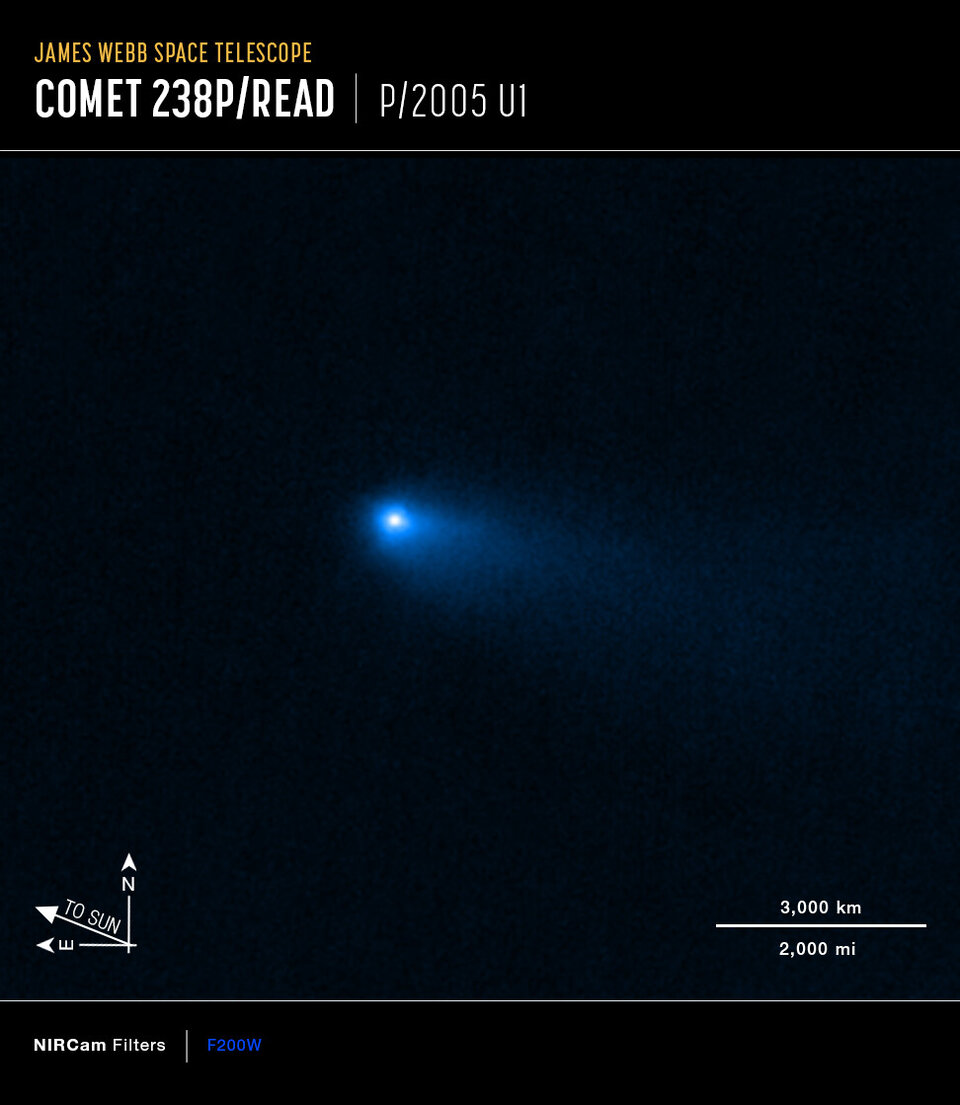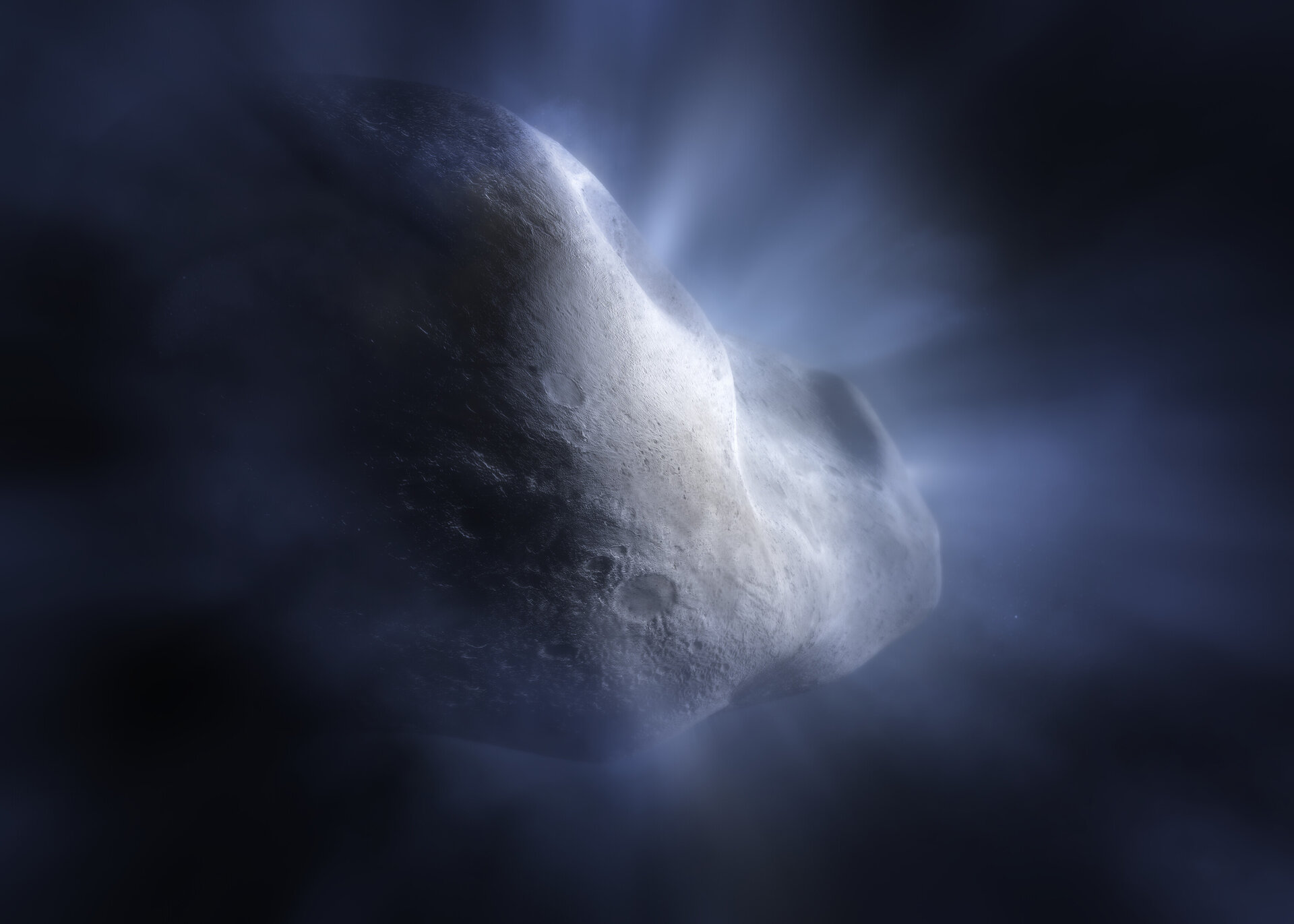Webb finds water, and a new mystery, in rare main-belt comet
The NASA/ESA/CSA James Webb Space Telescope has enabled another long-sought scientific breakthrough, this time for Solar System scientists studying the origins of the water that has made life on Earth possible. Using Webb’s NIRSpec (Near-Infrared Spectrograph) instrument, astronomers have confirmed gas – specifically water vapour – around a comet in the main asteroid belt for the first time, proving that water from the primordial Solar System can be preserved as ice in that region. However, the successful detection of water comes with a new puzzle: unlike other comets, Comet 238P/Read had no detectable carbon dioxide.

“Our water-soaked world, teeming with life and unique in the Universe as far as we know, is something of a mystery – we’re not sure how all this water got here,” said Stefanie Milam, Webb Deputy Project Scientist for Planetary Science and a co-author on the study reporting the finding. “Understanding the history of water distribution in the Solar System will help us to understand other planetary systems, and if they could be on their way to hosting an Earth-like planet,” she added.
Comet Read is a main-belt comet – an object that resides in the main asteroid belt but which periodically displays a halo, or coma, and tail like a comet. Main-belt comets themselves are a fairly new classification, and Comet Read was one of the original three comets used to establish the category. Before that, comets were understood to originate in the Kuiper Belt and Oort Cloud, beyond the orbit of Neptune, where their ices could be preserved farther from the Sun. Frozen material that vaporises as they approach the Sun is what gives comets their distinctive coma and streaming tail, differentiating them from asteroids. Scientists have long speculated that water ice could be preserved in the warmer asteroid belt, inside the orbit of Jupiter, but definitive proof was elusive – until Webb.

“In the past we’ve seen objects in the main belt with all the characteristics of comets, but only with this precise spectral data from Webb can we say yes, it’s definitely water ice that is creating that effect,” explained astronomer Michael Kelley of the University of Maryland, lead author of the study.
“With Webb’s observations of Comet Read, we can now demonstrate that water ice from the early Solar System can be preserved in the asteroid belt,” Kelley said.
The missing carbon dioxide was a bigger surprise. Typically carbon dioxide makes up about 10 percent of the volatile material in a comet that can be easily vapourised by the Sun’s heat. The science team presents two possible explanations for the lack of carbon dioxide. One possibility is that Comet Read did have carbon dioxide when it formed, but has lost that because of warm temperatures.
“Being in the asteroid belt for a long time could do it – carbon dioxide vaporises more easily than water ice, and could percolate out over billions of years,” Kelley said. Alternatively, he said, Comet Read may have formed in a particularly warm pocket of the Solar System, where no carbon dioxide was available.
The next step is taking the research beyond Comet Read to see how other main-belt comets compare, says astronomer Heidi Hammel of the Association of Universities for Research in Astronomy (AURA), lead for Webb’s Guaranteed Time Observations for Solar System objects and co-author of the study. “These objects in the asteroid belt are small and faint, and with Webb we can finally see what is going on with them and draw some conclusions. Do other main-belt comets also lack carbon dioxide? Either way it will be exciting to find out,” Hammel said.
Co-author Milam imagines the possibilities of bringing the research even closer to home. “Now that Webb has confirmed there is water preserved as close as the asteroid belt, it would be fascinating to follow up on this discovery with a sample collection mission, and learn what else the main-belt comets can tell us.”
The study is published in the journal Nature.
More information
ESA has a long history of exploring comets, both from a distance and up close. In 1986, the Agency's Giotto mission was the first to provide good resolution images of a comet's nucleus when it got close to Halley's Comet. Then during 2014–2016 Rosetta became the first mission to monitor how a comet changes as it swings around the Sun. Both Giotto and Rosetta's target comets are thought to have once originated from the outer reaches of the Solar System, but have since passed close to the Sun many times. ESA's next comet mission is different: due to launch in 2029, Comet Interceptor will be the first to visit a 'pristine' comet as it journeys into the inner Solar System for the first time. One of Comet Interceptor's ambitious goals is to explore how comets are responsible for delivering water to Earth, resulting in a life-friendly ecosystem.
Webb is the largest, most powerful telescope ever launched into space. Under an international collaboration agreement, ESA provided the telescope’s launch service, using the Ariane 5 launch vehicle. Working with partners, ESA was responsible for the development and qualification of Ariane 5 adaptations for the Webb mission and for the procurement of the launch service by Arianespace. ESA also provided the workhorse spectrograph NIRSpec and 50% of the mid-infrared instrument MIRI, which was designed and built by a consortium of nationally funded European Institutes (The MIRI European Consortium) in partnership with JPL and the University of Arizona.
Webb is an international partnership between NASA, ESA and the Canadian Space Agency (CSA).
Contact:
ESA Media relations
media@esa.int


